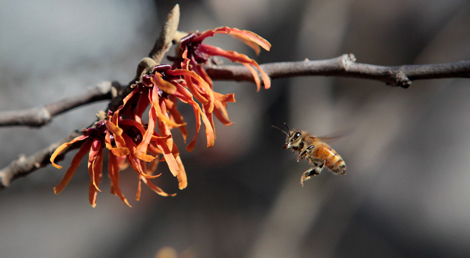
Pollinators in New York City
Other pollinators are also present in New York City’s urban landscapes and may be important, too, especially in early spring and late fall when bees are less active. These include flies, wasps, butterflies, beetles, various nocturnal pollinators, and the Ruby-Throated Hummingbird. From a conservation perspective, the biodiversity of all pollinators is significant, even if some groups or species are less effective than others.
In this section, you’ll find lots of information about the most important pollinators in the New York metropolitan region.
Pollinator Facts
- Studies indicate that bees account for 68 percent of visits to flowers in New York City parks and residential neighborhoods.
- After bees, the next most common visitors of flowers in the city are flies.
- Butterflies account for just 6 percent of New York City’s flower visitors.
- Honey bees pollinate approximately $15 billion worth of crops in the U.S. each year. The value of pollination services provided by native bees and other wildlife is even greater.
- Only 15 percent of the hundred or so crops that make up the world’s food supply are pollinated by domesticated honey bees. At least 80 percent are pollinated by wild bees and other wildlife.
- More than 100,000 different animal species — and perhaps as many as 200,000 — play a role in pollinating the planet’s flowering plants.
- Insects, including bees, wasps, moths, butterflies, flies, and beetles, are the most common pollinators, but as many as 1,500 species of birds, mammals, and other vertebrates also pollinate plants.
Bees
Most New Yorkers know that honey bees produce honey, live in hives, swarm in the spring, and have been declining recently due to the mysterious affliction known as Colony Collapse Disorder. Fewer New Yorkers, however, know about the city’s industrious and beneficial wild bees. Unlike honey bees, most of these are solitary—they live alone instead of in a hive. They nest in tunnels in the ground, and do not produce harvestable honey. These wild bees include bumble bees; large carpenter bees, which are among the “giants of the bee world”; mining bees, which live underground; brilliant green metallic bees; and even parasitic cuckoo bees, which attack the nests of other bee species.
In addition to the 200-plus bee species that have been found in New York City so far are a surprising number of exotic bees—16 of the estimated 40 exotic bees known to inhabit North America, indicating that New York is a port of entry or establishment for bees as well as other species including insects, plants, and people. Interestingly, bees do not migrate like some butterflies and birds. Rather most adult bees fly relatively briefly during the spring and/or summer and overwinter as individuals, not as a group within a hive. Many bees overwinter within their nests as mature larvae, but those that emerge early in spring overwinter as adults. Therefore, all bee species encountered in New York City can be viewed as year-round residents.
Unfortunately, there is increasing evidence that some wild bee species have experienced regional declines in North America, including the New York City area. Find out more about the threats to bees and how to help conserve them here.
Bees in the New York City area exhibit a wide range of lifestyles. They vary in where they build nests, whether they live in groups or alone, what plants they require, and how efficient they are as pollinators.
Types of bees in New York City
Six families of bees are found in the City. These include bees in the Family Andrenidae (at least 63 species), Apidae (at least 59 species), Halictidae (at least 46 species), Megachilidae (at least 40 species), Colletidae (at least 18 species), and Melittidae (3 species, although these have not been observed in several decades).
Bee Identification
For definitive identification of many bee species, close inspection of insect morphology (wing veins, leg parts, etc.) is required. This necessitates having specimens in hand to observe features under a microscope or through a hand lens. Numerous entomology texts detail how to collect and curate bees and other insects.
Some excellent online tools are also available, including the following web-based pictorial guides:
- Discover Life bee species guides cover all eastern North American bee genera. These link to associated species pages featuring dynamic maps, images, and descriptive text
- Bryn Mawr College and Rutgers University Native Bee Benefits, which includes a pictorial guide to important pollinators for farms in New Jersey and Pennsylvania
- Great Sunflower Project bee observer cards (this is not a regional guide but has useful information)
In addition to physically collecting insects, digital photography is increasingly being used to identify some bees. Digital photos of NYC bees (and of any North American insect) can be submitted to BugGuide for identification. Provided that relevant structures of the insect are in focus, bee and other insect taxonomy experts should be able to identify the insect in your image. BugGuide guide pages cover most species regularly identified from NewYork City.
Tips for Photographing Bees
Specialist Bee Plants
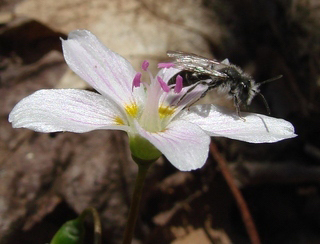
Bees can be classified by the range of plants they visit for nectar or pollen. So-called polylectic species are the most generalist, gathering pollen from multiple genera in more than one plant family. This is in contrast to oligolectic species, which gather pollen from two to several species in one plant family. Monolectic species have the most restricted floral requirements, feeding on only a single plant species, even when other species in the same genus are present. Roughly 80 percent of the bee species in New York City are polylectic, suggesting that they may be better able to make do with the types of flowers found in an urban environment. Following is a list of the plants required by the city’s 50 oligolectic or monolectic bees.
Aster Family (Asteraceae, 28 dependent bee species): One leaf-cutter bee, Megachile apicalis, specifically benefits from Centaurea, while the long-horned bee Melissodes desponsa specifically benefits from Cirsium. The other 26 bee species seem to have relatively broad tastes within the Aster Family.
Carrot Family (Apicaceae, 1 dependent bee species): The masked bee Hylaeus sparsus is very rare and has not been observed in New York City for several decades.
Cabbage Family (Brassicaceae, 1 dependent bee species): The miner bee Andrena arabis is also very rare and has not been observed for several decades.
Dogwood Family (Cornaceae, 3 dependent bee species): Plants in the genus Cornus, in particular, are preferred by three rare species of miner bee (genus Andrena).
Heath Family (Ericaceae, 4 dependent bee species): Plants in the genus Vaccinium (blueberries) are primarily used by the miner bee Andrena carolina and the Southeastern Blueberry Bee Habropoda laboriosa. Rhododendron is utilized by Andrena cornelli.
Geranium Family (Geraniaceae, 1 dependent bee species): This miner bee, Andrena distans, is very rare.
Mallow Family (Malvaceae, 1 dependent bee species): As its common name suggests, Ptilothrix bombiformis, the Hibiscus Bee, specifically prefers Hibiscus.
Water-lily Family (Nymphaceae, 1 dependent bee species): The small sweat bee Lasioglossum nelumbonis depends on flowers from water-lilies.
Evening Primrose Family (Onagraceae, 1 dependent bee species): Lasioglossum oenotherae, a small sweat bee, is dependent on evening primrose and other flowers in the genus Oenothera.
Primrose Family (Primulaceae, 3 dependent bee species): The exceptionally rare Macropis bees gather floral oils from yellow loosestrife flowers (genus Lysimachia). Because Epeoloides pilosula is a cleptoparasite of Macropis, this species is also indirectly dependent on Lysimachia.
Rose Family (Rosaceae, 1 dependent bee species): The one dependent species is a miner bee, Andrena melanochroa.
Willow Family (Salicaceae, 2 dependent bee species): The miner bees Andrena frigida and Andrena sigmundi both seem to prefer willows (genus Salix) and are quite rare.
Purslane Family (Portulaceae, 1 dependent bee species): The miner bee Andrena erigeniae, commonly known as the Spring Beauty Bee, was recently relocated by John Ascher, research scientist at the American Museum of Natural History, and colleagues on Staten Island.
Where bees live in NYC
Given the large amount of concrete and other impervious surfaces in New York City and surrounding suburbs, it’s interesting that 65 percent of the area’s bee species nest in the soil. Common soil nesters include miner bees (genus Andrena), small sweat bees (genus Lasioglossum), long-horned bees (genus Melissodes), and plasterer bees (genus Colletes). Including the nest parasites that depend on soil-nesting bees as their hosts, roughly 70 percent of bees in the city depend on soil for nesting. Sandy soil in coastal areas, silty banks near streams or rivers, sunny open fields, and the edges of hedgerows and forests are ideal, but even sparsely vegetated areas in parks or backyards that are not trampled or disturbed can serve as good nesting sites.
The quality and location of the soil matters. Studies have indicated that many bees prefer well-drained, sandy soils that are loose and friable so they can easily burrow. They also favor south-facing slopes. However, while this may be generally true, the specific soil texture and location required vary by species. For instance, two species of mining bees in the genus Anthophora build burrows in hard clay banks. Some bees can be observed nesting in garden soil, and some have even been observed building nests in potted plants. One observer found a plasterer bee building a nest in a potted Venus Fly Trap plant that had been placed outside for part of the summer!
When looking for bee nests in the soil, be aware that many animals build nests in the soil. If you see a hole it could be a bee, but it also could be a beetle, worm, wasp, ants, or something else. One way to find out is to place a plastic cup on the top of a suspected soil bee nest and wait to see what emerges. Our experience is that a garden, park, or other site that at first glance seems devoid of soil-nesting bees may, upon closer inspection, actually have many nests.
After soil, the next most common nesting location for bees in New York City is cavities, accounting for 24 percent of the City’s bees. Cavity-nesters are also often called “aerial nesters” because the cavities are typically in plant stems above the ground. Common cavity-nesters include leaf-cutter bees (genus Megachile), masked bees (genus Hylaeus), and mason bees (genus Osmia). Shrubs in which cavity-nesters are often observed include roses, hydrangeas, and lilacs. In general, however, any plant with pithy or hollow stems may be suitable for cavity-nesting bees. For strategies on protecting and providing bee nesting sites, see Management.
Just 6 percent of New York City bees nest in hives. This group includes the European honey bee and bumble bees. European honey bees may nest in managed hives—honey bee keeping recently was legalized in the City—or exist as feral colonies in hives located in parks, cemeteries, and other locations. Feral colonies are created when a new or deposed queen leads a swarm to a new nest location outside of the managed hive. This can be in a tree cavity, a hole in the side of a house, or a variety of other locations to which honey bee keepers are often called to remove bees each spring.
Bumble bees often nest in abandoned rodent nests, and possibly in tree cavities. Bumble bees are very abundant in New York City, so it is curious that nests are rarely reported. One nest was identified by citizen science bee watchers in ground ivy at Madison Square Park in Manhattan. By careful observation of bumble bee flight patterns, it should be possible to locate other nests.
Very few bee species in New York City are dependent on hard or rotting wood for nest sites. Three species of small sweat bee (genus Lasioglossum) and one species of green metallic bee (Augochlora pura) nest in rotting wood. Just one species, the large Eastern Carpenter Bee (Xylocopa virginica), constructs nests in hard wood. The entrances to carpenter bee nests can be identified as nearly perfect dime-sized circles, which often have a small pile of sawdust on the ground below them. By placing your ear to the wood near a nest hole, it is often possible to hear the female bee chewing wood as she excavates the nest tunnel.
These nesting sites need to be close to good food supplies—fields or forest edges or gardens with abundant yet diverse nectar and pollen sources that are available throughout the season, from early April through October. Also essential are so-called habitat corridors that connect nesting and foraging sites, to allow bees safe passage as they travel to and fro gathering pollen and nectar for their young. For more information on nesting requirements, see Management.
Nest Bandits
Who bees live with in NYC
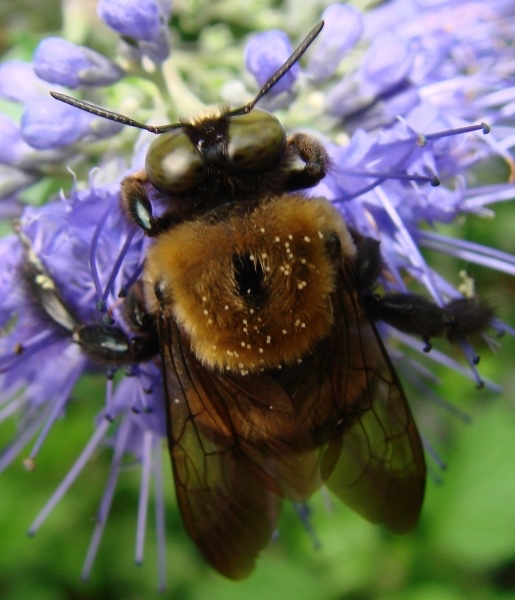
Just as the majority of New York City’s bees nest in the soil, most, or 151 species, live a solitary and/or communal existence. In solitary species, a reproductive female constructs a nest, provisions it with pollen, lays eggs, and then leaves. After that, the larvae are on their own—there is no further care or provisioning from the mother. Some solitary bees construct nests near other nests (termed “aggregations”) or even share a single nest (called “communal”). Species with aggregations or communal nests, however, are still considered solitary if the reproductive females provide no further care after the initial provisioning of the nests with pollen. Solitary bees include miner bees (genus Andrena, 58 species), leaf-cutter bees (genus Megachile, 18 species), mason bees (genus Osmia, 26 species), masked bees (genus Hylaeus, 11 species), long-horned bees (genus Melissodes, 9 species), plasterer bees (genus Colletes, 7 species; note that plasterer bees are considered solitary because each female builds her own nest for rearing young, although they often form aggregations where many nests are close to each other), small sweat bees (genus Lasioglossum, 6 species; note, however, that some small sweat bees species are primitively eusocial—see below for details), and small carpenter bees (genus Ceratina, 3 species).
The solitary lifestyle contrasts with the behavior of “subsocial” species—four in New York City— in which the mother continues to feed the larvae as they develop, a progressive step towards greater social interaction. Subsocial species in the city include the large Eastern Carpenter Bee (Xylocopa virginica), and three much rarer bees: Pseudopanurgus compositarum (Family Andrenidae), Ptilothrix bombiformis (Family Apidae), and Svastra oblique (Family Apidae). There are other types of social behavior in bees as well, such as “parasocial,” “quasisocial,” “semisocial,” and even “sleeping aggregations.” For more information about these, see The Social Behavior of the Bees: A Comparative Study by Charles Michener, which is available for free via Google Books.
Fifteen percent of New York City’s bee species are termed “eusocial” because they exhibit much more complex social behavior, including physically differentiated castes such as workers, drones, and queens that contribute in different ways to the well-being of the colony by foraging, for example, or reproducing. Bumble bees (genus Bombus, 11 species), some small sweat bees (genus Lasioglossum, 19 species), and some green metallic bees (genus Halictus, 3 species) are classified as “primitively eusocial” because colonies are not perennial—all individuals die in the fall except for the new queens who hibernate and then create new colonies in the spring. European honey bees are the only species classified as “advanced eusocial” because the colonies are perennial and there is greater differentiation in the physical attributes of the castes.
Three species of bee in New York City exhibit a specific type of cleptoparasitism called “social cleptoparasitism.” In these species, a female enters the nest and kills the queen of the social host species in addition to any developing larvae. She then lays eggs and effectively becomes the new queen of the colony. Workers of the host species care for the developing young of the parasitic species. Social parasites include the common Lemon Cuckoo Bumble Bee (Bombus citrinus), which parasitizes the nests of other bumble bee species, and the somewhat rarer Lasioglossum cephalotes and Lasioglossum platyparium, which both parasitize other small sweat bees.
Species of Concern
Connecticut
Connecticut recently listed the Macropis Cuckoo Bee ( Epeoloides pilosula) as endangered and the Fringed Loosestrife Oil Bee ( Macropis ciliata) as a species of special concern. Three bumble bees are also listed as species of special concern, without formal protection — the Affable Bumble Bee ( Bombus affinis), Ashton’s Bumble Bee ( Bombus ashtoni), and Yellowbanded Bumble Bee ( Bombus terricola). Several butterfly and moth species are listed as threatened and/or endangered species in the state, affording them legal protection from harassment. Examples include the Northern Metalmark ( Calephelis borealis), endangered; Hessel’s Hairstreak ( Mitoura hesseli), endangered; and Frosted Elfin ( Callophrys irus), threatened.New York
New York State has no protection for native bee species but does afford protection for a number of butterfly and moth species, including the Regal Fritillary ( Speyeria idalia), Arogos Skipper ( Atrytone arogos), Hessel’s Hairstreak ( Mitoura hesseli), and Frosted Elfin ( Callophrys irus).New Jersey
New Jersey has no protection for native bee species but does afford legal protection for a number of rare moth and butterfly species, such as the Arogos Skipper ( Atrytone arogos) and Frosted Elfin ( Callophrys irus).Regional
Some protected areas have special regulations for pollinators in place, such as the Albany Pine Bush in New York State, which protects critical habitat for the federally protected Karner Blue butterfly ( Lycaeides melissa samuelis).
Honey Bees
Although Honey bees are not endangered, a couple of groups are involved in promoting honey bee health in the region. To learn more about honey bees visit:
Mid-atlantic Apiculture Research and Extension Consortium
Interested in beekeeping in NYC?
New York City Beekeepers Association
Other Pollinators
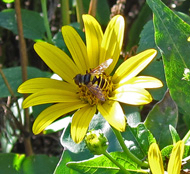
Although bees are generally considered the most important, a number of other pollinators are also present in urban landscapes. Following are some other pollinators that have been observed in New York City.
Flies
After bees, the next most common visitors of New York City flowers are flies, especially syrphid or “flower flies” in the genera Toxomerus and Syrphus. The few studies of their ability to transmit pollen suggest that they can be effective pollinators of sweet peppers, strawberries, goldenrods, and many other plants. Bee flies (Bombylius species) are another interesting group of flies that are commonly seen in early spring and are excellent pollinators of spring wildflowers like the spring beauty (Claytonia species). It is unclear, however, how many species of pollinating flies are in the New York City area, or which ones are most effective at pollinating different flowers.
Wasps
Wasps, which are often confused with bees, are sometimes observed on flowers. Bees can be considered “vegetarian” wasps because they feed their larvae pollen whereas many wasps feed their larvae insect prey. However, adults of both bees and wasps may visit flowers for nectar. Most wasps are not very hairy and thus probably have a relatively low likelihood of transmitting pollen. Common wasp flower visitors include social “yellow jacket” or “paper wasps” such as Vespula maculifrons and Polistes dominulus.
Butterflies and Moths
Butterflies are conspicuous when present but not nearly as abundant as bees, comprising just 6 percent of the flower visitors in New York City. Unlike bees, which actively collect pollen and nectar to feed to their young, butterflies as well as moths visit flowers only to seek nourishment from flower nectar for themselves. In addition, because most butterflies have long legs, the likelihood of their body contacting and transmitting pollen may be much lower than bees. Nevertheless, the diversity of butterflies in the New York City area is quite high—at least 110 species were documented in a 50 km radius of the city from 2001 to 2010. Some butterflies, such as the Bronze Copper and Silver-bordered Fritillary, are quite rare and worthy of conservation.
Some observant New Yorkers have noted groups of Monarchs flying down Broadway in Manhattan in the fall. In heavy Monarch butterfly (Danaus plexipus) migration years, there have even been reports of “clouds of orange” moving down the Hudson or Palisades. Before crossing the various water bodies in the metropolitan area, butterflies often “power up” by sipping nectar from late-blooming flower species such as asters. One observer witnessed over 60 Monarch butterflies sipping nectar from one large clump of aster on City Island in the Bronx, with individual Monarchs eventually “taking the plunge,” flying across Eastchester Bay to Long Island, en route to more distant warmer climes. New York City’s beaches are also congregating areas where Monarchs feed on seaside goldenrod and roost in bayberry shrubs before continuing their trip to the mountains of Mexico.
Beetles
Although beetles are important pollinators of several plants in tropical regions, they are not commonly observed on flowers in the New York City area. Tumbling Flower Beetles (Family Mordellidae) and June Beetles (Family Scarabidae) are among the beetles that have been observed on flowers here. Other beetles in this area may be nocturnal pollinators (see below). In particular, magnolias, pond lilies, goldenrod, and spirea are visited and pollinated by beetles.
Nocturnal pollinators
Most of the pollinators described thus far are active during the day. However, nocturnal pollinators such as moths, beetles, flies, and other insects may also be important for certain plants. Few studies of nocturnal pollinators in the New York City region have been done, so it is unclear exactly how abundant and important they are. Flowers dependent on nocturnal pollinators are often white, pale yellow, or pink. Hawk moths (Family Sphingidae), for example, are nocturnal pollinators of evening primrose and other Oenothera species.
Hummingbirds
The only resident species of hummingbird in the Northeast is the Ruby-throated Hummingbird, although several other hummingbird species sometimes move through the area. The tiny birds are actually summer residents, flying south as far as Central America for the winter. Hummingbirds are generally known for visiting tubular red or orange flowers such as orange jewelweed (Impatiens capensis), native coral honeysuckle (Lonicera sempervirens), scarlet bee balm (Monarda didyma), cardinal flower (Lobelia cardinalis), and trumpet creeper (Campsis radicans), which is self-incompatible and has been shown to greatly benefit from hummingbird pollination, relative to pollination by honey bees or bumble bees.
Resources
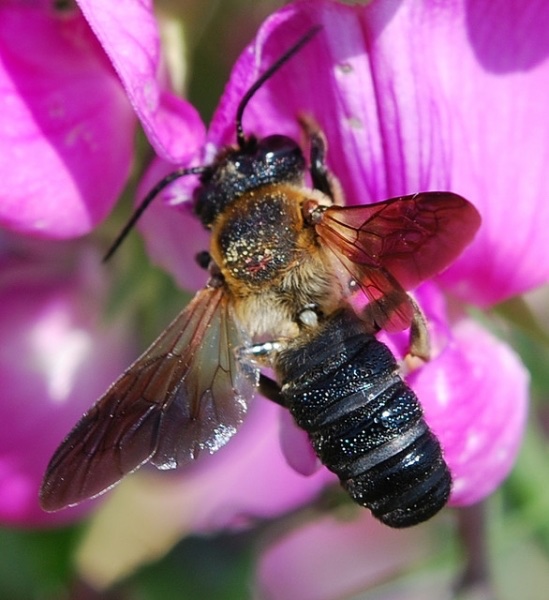
New York City Bee Information
City Bees Newly Discovered, Yet Here All Along – New York Times blog about new sweat bee discovery Lasioglossum gotham by Erik Olsen (2011).
Bees and the City – New York Times Op Ed (2011).
Entomologist John Ascher of the American Museum of Natural History on WNYC’s Brian Lehrer Show discusses the recent bee swarms in New York City and Colony Collapse Disorder (2008).
One of our very own Bee Watchers, Lesley Meurer, office manager at the Greenbelt Nature Center, is featured in a local newspaper (2009).
Video
Honey bee swarm in Lefferts Manor, Brooklyn (shared by Timothy Forker)
PDFs and Handouts
Honey Bee Disappearance and What You Can Do (NAAPC)
Better with Bees – discusses the benefits of bees in urban gardens
More on Native Pollinators
NPR interview with entomologist Stephen Buchmann, co-author of The Forgotten Pollinators, in honor of pollinator week (2009).
National Wildlife magazine article about native pollinators (2009).
Great Pollinator Project coverage in The New York Academy of Sciences (2009).
The role of native bees in apple pollination: Native bees are better pollinators, more plentiful than honeybees, finds entomologist. (2011).
The Pollinator bibliographic database includes more than 10,000 references about pollination biology, an invaluable resource. Developed and maintained by David Inouye.
Insect and Bee Conservation Organizations
The Xerces Society is the leader in invertebrate conservation, and their site has many resources of value to those interested in preserving bees.
North American Pollinator Protection Campaign — a collaborative effort by scientists, researchers, conservationists, government officials, and volunteers to raise pollinator-related issues, and to benefit the health of all species, particularly those most threatened.
Pollinator Partnership works to protect the health of managed and native pollinating animals vital to North American ecosystems and agriculture. Among the wealth of information on the P2 website are ecoregional planting guides for pollinators.
Gardening for Pollinators
Delaware Native Plants for Native Bees (USDA-NRCS and Delaware Department of Agriculture: technical bulletin).
Michigan State University – Enhancing Beneficial Insects with Native Plants – Includes a wealth of information including publications and power point presentations on native plants, pollinators and other beneficial insects, and farms.
Urban Bee Gardens—This UC Berkeley research group website provides a wealth of practical information about native bees and gardening.
Honey Bees
The Bee Works—Provides information about beekeeping, including requeening, feeding methods, and how to determine the hybridization of a colony through morphometry, as well as beekeeping equipment available for purchase.
Discover magazine article on colony collapse syndrome (2009).
Time magazine article, The Plight of the Honeybee (August 2013).
Butterflies and Moths
North American Butterfly Association – promotes butterfly observation and gardening for butterflies. See North Jersey Chapter websitefor local and regional activities.
The Lepidopterists’ Society – devoted to the study and conservation of butterflies and moths.
History of the NYC Bee Watchers and Great Pollinator Project
Bee Watchers
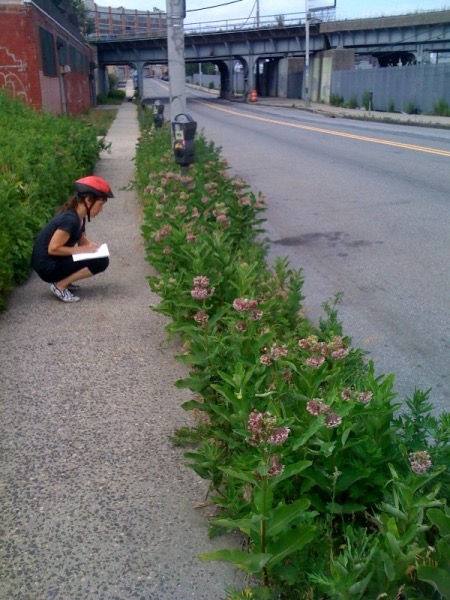
In 2007, the Center for Biodiversity and Conservation and the Greenbelt Native Plant Center began the Great Pollinator Project (GPP) in collaboration with the Great Sunflower Project in San Francisco. The goals of the GPP were to:
- Increase understanding of bee diversity in New York City and the surrounding region;
- Raise public awareness of native bees and their importance; and
- Improve park management and home gardening practices to benefit bee conservation in cities.
Citizen Science Bee Watchers Research Project
The purpose of the Bee Watchers project was to identify areas of New York City with good pollinator service by determining how quickly bees arrived during observation periods to pollinate flowers in backyards and gardens.
Methods: During the summers of 2007 – 2010, a total of 125 volunteer Bee Watchers observed the bees visiting a suite of native flowering plant species (purple coneflower, mountain mint, common milkweed, rough-leaved goldenrod, smooth aster, bee balm, woodland sunflower and annual sunflower) at locations throughout the five boroughs of New York City. Observed bees were “assigned” to one of five categories: honey bee, bumble bee, large carpenter bee, shiny green bee, and “other” type of bee. Over the four summers of observation, Bee Watchers submitted almost 1,500 observations from all five boroughs of the city.
General Results: The eight different flowers that were included in this study varied in how quickly and consistently they attracted bees. They also varied in the degree to which nearby flowers and surrounding landscape influenced bee visitation. For the purposes of this report, we provide general findings for all flowers combined. Generally, focal flowers located in more natural areas (parks, community and private gardens) were more successful at attracting bees than those in more artificial settings such as rooftop gardens, window boxes, and street-side locations. In addition, focal flowers in gardens with more nectar resources (e.g., those with more than 100 flowers) were visited by more bees than those located in areas with fewer surrounding floral resources. Theoretically, a large number of surrounding flowers could compete for pollinators and end up reducing bee visitation to focal plants. Contrary to this idea, however, our results indicate that an abundance of surrounding flowers facilitates increased pollination service to focal plants. This suggests a “magnet effect” whereby increased floral resources attract an abundant and diverse pollinator community, which then leads to increased pollination services for many flowers in the area.
Land-Cover Analysis Results: We also looked at the land cover (tree canopy, grass/shrubs, bare earth, water, buildings, roads, other paved surfaces) around each observation point using raster files provide by New York City Department of Parks and Recreation. These cover types were ultimately grouped into two main habitats: natural (tree canopy plus grasses/shrubs) and hard surfaces (buildings, roads, and other pavement). (Water and bare ground made up less than 1% of the habitat so were not included). Results indicate that the percentage of natural habitat up to 100 meters around an observation point (approximately 1 city block) plays a significant role in determining pollinator (bee) visitation to focal plants. This highlights the importance of increasing green space at the neighborhood scale to benefit local pollination service. This can be achieved by creating community and rooftop gardens, adding flower beds to front and back yards, and increasing green space wherever possible.
Other GPP research: We also worked with volunteers to determine what motivated them to become citizen scientists. Results of this work can be found in: Toomey, A.H. and M.C. Domroese. 2013. Can citizen science lead to positive conservation attitudes and behaviors? Human Ecology Review (20)1:50-62. Additional publications are being submitted to various journals but as of this date (April 2014) have not been published. Any questions, please contact Liz Johnson (ejohnson@amnh.org or beewatchers@gmail.com).
In Their Own Words
In 2009, volunteer Bee Watchers gathered in a focus group to talk about how the project had changed their life. Here’s a bit of what they said:
“…everywhere I go now I look for bees…I look at plants and the bees on those flowers. Out of curiosity.”
“Once you’re sensitized you can’t not watch them. You can’t not be more sensitive to movement… more aware of subtle distinctions between bees.”
“I used to garden for vegetables or pretty flowers, and now I garden for the bees.”
“It’s interesting to see that there is nature in New York City and how pervasive it is. You never thought of it in all this concrete and streets…but there’s quite a lot of activity when you look in detail.”
Acknowledgements
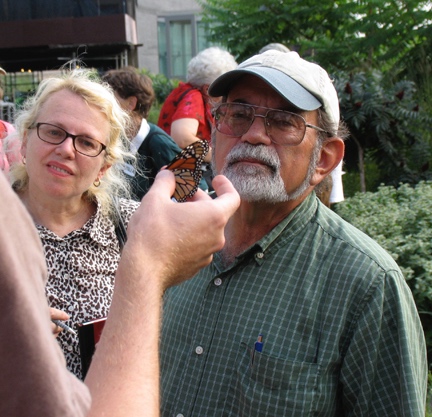 We are grateful to the New York City Environmental Fund for partially funding this project. Additional funding was provided by Together Green fund.
We are grateful to the New York City Environmental Fund for partially funding this project. Additional funding was provided by Together Green fund.
Many thanks to our wonderful Bee Watcher volunteers; Gretchen LeBuhn (Great Sunflower Project); John Ascher and Jerome Rozen (AMNH); Jim Cane (USDA-ARS); Sam Droege (USGS); Ed Green (Rutgers University); Bob Unnasch (Sound Science); Amy Colorado; Ruth Lowell; staff of the Greenbelt Native Plant Center; and to the parks and nature centers who hosted the annual orientation sessions through the years: Alley Pond Environmental Center, Brooklyn Botanic Garden, Central Park Conservancy, Greenbelt Nature Center, Prospect Park Audubon Center, and Bronx Borough Parks Headquarters, Van Cortlandt Park.
Thanks also to the following photographers who graciously shared their images with us: J. Ascher, J. Baker (Wiki Commons), J. Bourque, M. Domroese, P. Ersts, G. Gallice (Wiki Commons), E. Johnson, J. Katz, C. Landis, K. Matteson, Max.Oppo (Wiki Commons), T. Murray, S. Nanz, T. Phillips, J. Plewka, R.E. Poplin (Wiki Commons), J.M. Schneid (Wiki Commons), Thomas of Baltimore City, R. Weidenaar.
Website Credits
Content development: Elizabeth Johnson, Kevin Matteson, and Edward Toth
Online data entry: Peter Ersts
Design: Genevieve Hitchings and Ho-Ling Poon
Website architecture and content editing: Janet Marinelli
